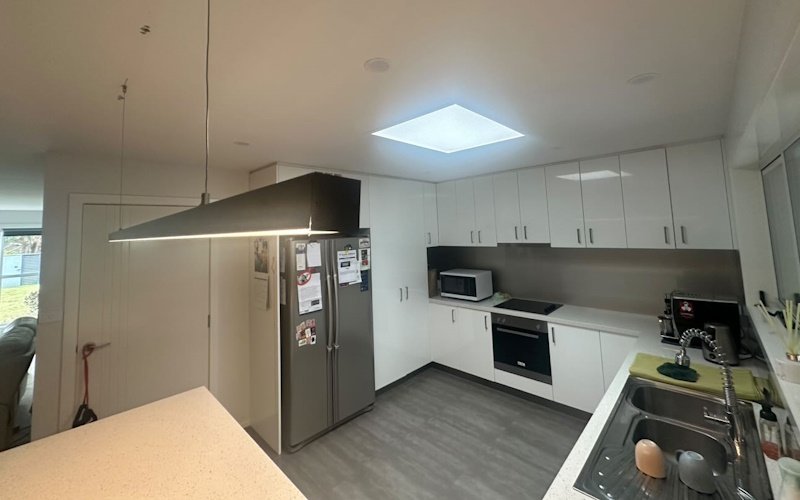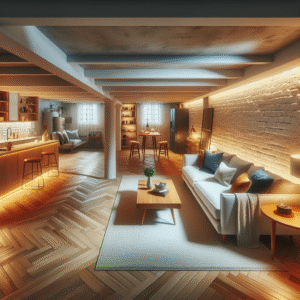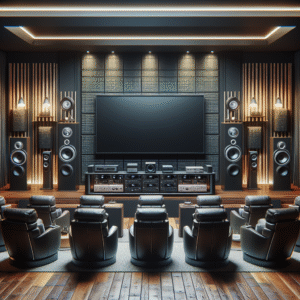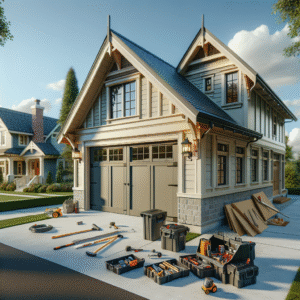A kitchen remodel is one of the most impactful home improvement projects you can undertake. Whether you’re updating an outdated space, improving functionality, or creating your dream kitchen, a successful remodel can increase your home’s value and make your kitchen a more enjoyable space for everyday life. However, kitchen remodels require careful planning, budgeting, and decision-making to ensure the best outcome.
In this comprehensive guide, we’ll walk you through every step of the kitchen remodeling process, from planning and budgeting to choosing materials and hiring the right professionals. By the end, you’ll have all the information you need to start your kitchen transformation with confidence.
1. Define Your Kitchen Remodel Goals
Before diving into your kitchen remodel, it’s essential to define your goals. Understanding what you want to achieve will guide your decisions and help you communicate your vision to contractors and designers. Ask yourself the following questions:
- What’s your primary reason for remodeling? Are you looking to update a dated kitchen, improve functionality, increase storage, or enhance aesthetics?
- What’s your budget? Setting a clear budget upfront will help you prioritize your spending and avoid overspending.
- Do you have a specific style in mind? Whether you prefer a modern, traditional, or farmhouse style, having a clear idea of the design direction will help guide material and layout choices.
- What features are most important to you? Do you need more counter space, better lighting, energy-efficient appliances, or a larger kitchen island?
Having clear goals from the outset will make the planning process smoother and ensure that your remodel meets your needs and expectations.
2. Set a Realistic Budget
Setting a realistic budget is one of the most critical steps in a kitchen remodel. Kitchen renovations can vary widely in cost, depending on the scope of work, materials used, and whether you plan to make structural changes. A typical kitchen remodel can cost anywhere from $10,000 to $50,000 or more, depending on the complexity of the project.
Budgeting Tips:
- Allocate funds to the most important elements: Prioritize areas that have the biggest impact, such as cabinets, countertops, and appliances. If you’re on a tight budget, consider leaving the plumbing and electrical systems in their current locations to avoid additional costs.
- Add a buffer for unexpected expenses: It’s a good idea to set aside 10-20% of your budget for unexpected costs, such as plumbing issues or additional labor.
- Get multiple quotes: When hiring contractors, get at least three quotes to compare pricing. This will give you a better understanding of the market rate for your project and ensure you’re getting a fair price.
By setting a clear budget and sticking to it, you can ensure that your kitchen remodel stays within financial reach.
3. Choose Your Kitchen Layout
The layout of your kitchen is one of the most important decisions you’ll make during your remodel. A functional kitchen layout can improve workflow, enhance storage, and make cooking and entertaining more enjoyable. Common kitchen layouts include:
L-Shaped Kitchen:
An L-shaped kitchen features two walls of cabinets and countertops that meet at a corner, forming an “L” shape. This layout is ideal for open-plan kitchens and provides ample counter space while maintaining an efficient work triangle.
U-Shaped Kitchen:
In a U-shaped kitchen, cabinets and countertops are installed along three walls, creating a U shape. This layout maximizes storage and counter space, making it ideal for larger kitchens. It’s also a great choice for those who cook frequently.
Galley Kitchen:
A galley kitchen features two parallel walls of cabinets and appliances, creating a narrow, corridor-like space. While compact, this layout can be highly efficient for small kitchens and offers easy access to everything within a short distance.
Island Kitchen:
An island kitchen includes a central island that provides additional counter space, storage, and seating. Islands are versatile and can serve as a prep area, dining space, or even a homework station for kids.
When deciding on a layout, consider how you use your kitchen, the available space, and how the layout will impact traffic flow. Working with a kitchen designer or contractor can help you determine the best layout for your needs.
4. Select Materials and Finishes
Choosing materials and finishes is one of the most exciting parts of a kitchen remodel. From cabinets and countertops to flooring and backsplashes, the materials you select will set the tone for your kitchen’s design. Here’s a breakdown of key material choices:
Cabinets:
Cabinets are one of the most prominent features of a kitchen and can significantly impact both the aesthetic and functionality of the space. You’ll need to choose the material, style, and color of your cabinets.
- Material: Popular cabinet materials include solid wood, plywood, and medium-density fiberboard (MDF). Wood cabinets offer a classic look, while MDF is a more affordable option that can be painted or laminated.
- Style: Shaker-style cabinets are a popular choice for both modern and traditional kitchens due to their clean lines. Flat-panel cabinets are sleek and contemporary, while raised-panel cabinets offer a more formal look.
- Color: White and neutral tones are timeless, but bold colors like navy blue, forest green, and matte black are increasingly popular for kitchen cabinets.
Countertops:
Countertops are another key element of your kitchen’s design. When choosing a countertop material, consider durability, maintenance, and aesthetics.
- Quartz: Quartz countertops are engineered from natural stone and resin, making them highly durable, non-porous, and resistant to stains. They come in a wide range of colors and patterns.
- Granite: Granite is a natural stone that offers a luxurious, high-end look. It’s durable and heat-resistant but requires regular sealing to prevent stains.
- Marble: Marble countertops are elegant and timeless but require more maintenance due to their porous nature.
- Laminate: Laminate is a budget-friendly option that mimics the look of natural stone or wood. It’s easy to clean but less durable than other materials.
Flooring:
Kitchen flooring should be durable, water-resistant, and easy to clean. Popular options include:
- Hardwood: Hardwood floors add warmth and natural beauty to a kitchen. Engineered wood is a good choice for kitchens as it’s more resistant to moisture.
- Tile: Ceramic and porcelain tile are water-resistant and available in a wide range of styles. Tile floors are durable but can be hard underfoot.
- Vinyl: Vinyl flooring is affordable, water-resistant, and available in a variety of designs, including options that mimic hardwood or stone.
Backsplash:
The backsplash is a functional and decorative element that protects the walls behind your stove and sink from water and grease. Popular backsplash materials include subway tile, glass, and natural stone. You can also experiment with patterns and colors to add personality to your kitchen.
5. Hire the Right Professionals
A kitchen remodel is a complex project that often requires multiple professionals, including contractors, electricians, plumbers, and possibly a designer. Hiring the right team is critical to the success of your remodel.
Steps to Hiring a Contractor:
- Research and Get Recommendations: Ask friends, family, or neighbors for contractor recommendations. You can also use online platforms like Angi, HomeAdvisor, or Yelp to find contractors in your area.
- Check Licensing and Insurance: Verify that the contractor is licensed and insured to protect yourself from liability.
- Review Portfolios and Ask for References: Look at previous kitchen remodels the contractor has completed to assess their work quality and style. Contact past clients to ask about their experience.
- Get Detailed Quotes: Request detailed quotes from at least three contractors. Compare the scope of work, materials, and timelines provided in each quote.
If you’re working with a designer, they can also help manage the project and coordinate with contractors to ensure the design is executed correctly.
6. Consider Energy-Efficient Appliances
A kitchen remodel is the perfect opportunity to upgrade to energy-efficient appliances that can save you money on utility bills and reduce your carbon footprint. Look for appliances with the ENERGY STAR label, which indicates they meet energy efficiency guidelines set by the U.S. Environmental Protection Agency (EPA).
Key Energy-Efficient Appliances:
- Refrigerators: ENERGY STAR-rated refrigerators use 10-15% less energy than non-rated models. Consider models with a top freezer, as they tend to be more energy-efficient.
- Dishwashers: Energy-efficient dishwashers use less water and electricity while still providing excellent cleaning performance. Look for models with soil sensors and energy-saving cycles.
- Ovens and Stoves: Induction cooktops are highly energy-efficient and heat food faster than traditional electric or gas stoves. Convection ovens circulate hot air to cook food more evenly and quickly, reducing energy consumption.
Upgrading to energy-efficient appliances not only helps the environment but can also enhance the overall functionality of your kitchen.
7. Plan for Lighting and Ventilation
Lighting and ventilation are often overlooked in kitchen remodels, but they play a crucial role in both functionality and comfort. A well-lit kitchen ensures that cooking and food prep areas are properly illuminated, while good ventilation prevents smoke, steam, and odors from lingering in the space.
Lighting Tips:
- Task Lighting: Install task lighting under cabinets to illuminate countertops where food preparation occurs. LED strip lights are an excellent choice for this.
- Ambient Lighting: Ceiling lights, such as recessed lights or flush mounts, provide overall illumination for the kitchen. Dimmable lights allow you to adjust the brightness based on the time of day or activity.
- Accent Lighting: Add pendant lights or chandeliers above the kitchen island or dining area to create a focal point and enhance the kitchen’s aesthetic.
Ventilation Tips:
- Range Hoods: A powerful range hood is essential for proper ventilation. Choose a model that is appropriately sized for your stove and can effectively vent smoke and steam outside.
- Exhaust Fans: In addition to a range hood, you may want to install an exhaust fan to improve air circulation and remove odors from the kitchen.
Good lighting and ventilation improve the functionality of your kitchen and create a more comfortable space for cooking and entertaining.
8. Plan for Temporary Disruptions
A kitchen remodel can disrupt your daily life, especially if you use the kitchen frequently for cooking and dining. Planning ahead for these disruptions will help reduce stress during the renovation process.
How to Prepare:
- Set Up a Temporary Kitchen: Create a temporary kitchen space in another part of your home where you can store food, prepare meals, and wash dishes. A microwave, mini-fridge, and portable electric cooktop can help you get by while your kitchen is out of commission.
- Stock Up on Easy-to-Prepare Meals: Consider preparing meals ahead of time or relying on easy-to-make options such as sandwiches, salads, and frozen meals.
- Plan for Dining Out: Depending on the length of your remodel, you may need to eat out more frequently. Budget for additional dining expenses during the renovation.
By planning for temporary disruptions, you can make the remodel process more manageable and less stressful for your household.
FAQ
1. How long does a kitchen remodel typically take?
A standard kitchen remodel can take anywhere from 4 to 12 weeks, depending on the scope of work. Larger or more complex projects may take longer.
2. What is the average cost of a kitchen remodel?
The cost of a kitchen remodel can range from $10,000 to $50,000 or more, depending on the size of the kitchen, materials used, and labor costs.
3. Can I stay in my home during a kitchen remodel?
Yes, most homeowners stay in their homes during a kitchen remodel, but you’ll need to plan for temporary disruptions, such as setting up a temporary kitchen and dining out more frequently.
4. Should I hire a kitchen designer?
Hiring a kitchen designer can be beneficial, especially for complex projects. A designer can help create a functional layout, choose materials, and manage the project.
5. How can I save money on my kitchen remodel?
To save money, focus on high-impact areas like cabinets and countertops, leave plumbing and electrical systems in place, and consider using budget-friendly materials like laminate countertops or MDF cabinets.
Conclusion
A kitchen remodel is a major project that requires careful planning, budgeting, and decision-making. By setting clear goals, choosing the right materials, hiring experienced professionals, and preparing for temporary disruptions, you can ensure a successful remodel that enhances the beauty and functionality of your kitchen. With the right approach, your dream kitchen will become a reality, adding value to your home and improving your everyday life.








